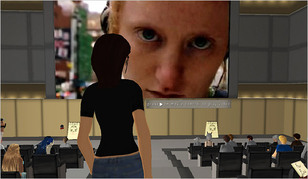Virtual worlds and the future of TV
n

“…If the wildest dreams of some very excited technology developersncome true, virtual reality might finally be the medium that unites thenpassive experience of watching television with the interactivenpotential of the Web. If that happens, the television industryn— which has not been particularly speedy in adapting to the Internetnrevolution — sees an opportunity not only to recover lost ground fromnonline competitors but also to take a lead, and in so doing create annentirely new environment in which to influence and sell to its audience. “Younwant to be in this because you know, as a content provider, that thisnis where the future is going,” said Quincy Smith, the president of CBSnInteractive. “I don’t look at it as science fiction. I look at it asnthe future of communication.”
If TV killed the radio star, maybe Second Life will save the TV star?
nn
[image: A virtual screening room in Second Life]
n




